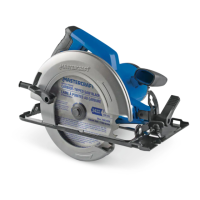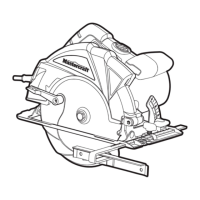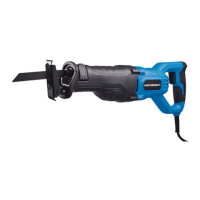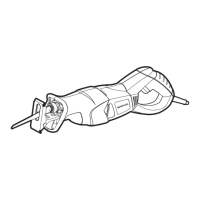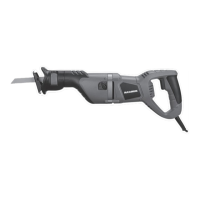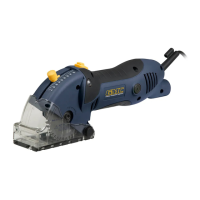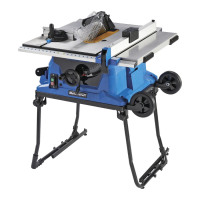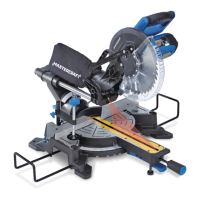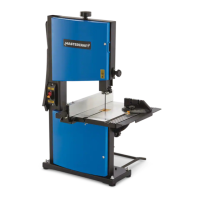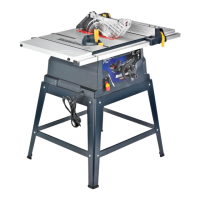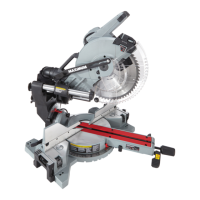7 8
7 1/4" CIRCULAR SAW - 054-8357-67 1/4" CIRCULAR SAW - 054-8357-6
SAFETY GUIDELINES
SAFETY GUIDELINES
•
Neverholdthepiecebeingcutinyourhandsoracrossyourleg.Secure the workpiece to a stable
platform. It is important to support the work properly to minimize body exposure, blade binding, or loss
of control.
•
Holdthepowertoolbyitsinsulatedgrippingsurfaceswhenperforminganoperationwherethe
cuttingtoolmaycontacthiddenwiringoritsowncord.Contact with a “live” wire will also make
exposed metal parts of the power tool “live” and shock the operator.
•
Whenripping,alwaysusearipfenceorstraightedgeguide. This improves the accuracy of the cut
and reduces the chance of blade binding.
•
Alwaysusebladeswithcorrectsizeandshape(diamondversusround)arbourholes. Blades that
do not match the mounting hardware of the saw will run eccentrically, causing loss of control.
•
Neverusedamagedorincorrectbladewashersorbolt. The blade washers and bolt were specially
designed for your saw for optimum performance and safety of operation.
Further safety guidelines for all saws
CAUSE AND OPERATOR PREVENTION OF KICKBACK:
•
Kickbackissuddenreactiontoapinched,boundormisalignedsawblade,causingan
uncontrolledsawtoliftupandoutoftheworkpiecetowardtheoperator.
•
Whenthebladeispinchedorboundtightlybythekerfclosingdown,thebladestallsandthe
motorreactiondrivestheunitrapidlybacktowardtheoperator.
•
Ifthebladebecomestwistedormisalignedinthecut,theteethatthebackedgeoftheblade
candigintothetopsurfaceofthewood,causingthebladetoclimboutthekerfandjumpback
towardtheoperator.
Kickbackistheresultofsawmisuseand/orincorrectoperatingproceduresorconditionsandcan
beavoidedbytakingproperprecautionsasgivenbelow:
•
Maintainarmgripwithbothhandsonthesawandpositionyourarmstoresistkickback
forces. Position your body to either side of the blade, but not in line with the blade. Kickback could cause
the saw to jump backwards, but kickback forces can be controlled by the operator, if proper precautions
are taken.
•
Whenthebladeisbinding,orwheninterruptingacutforanyreason,releasethetriggerandhold
thesawmotionlessinthematerialuntilthebladecomestoacompletestop.Never attempt to
remove the saw from the work or pull the saw backward while the blade is in motion or kickback may
occur. Investigate and take corrective actions to eliminate the cause of blade binding.
•
Beforerestartingthesawintheworkpiece,centrethesawbladeinthekerfandcheckthatsaw
teetharenotengagedintothematerial. If saw blade is binding, it may walk up or kickback from the
workpiece as the saw is restarted.
•
Supportlargerpanelstominimizetheriskofbladepinchingandkickback. Larger panels tend to
sag under their own weight. Supports must be placed under the panel on both sides: near the line of cut
and near the edge of the panel.
•
Donotusedullordamagedblades.Unsharpened or improperly set blades produce narrow kerf,
causing excessive friction, blade binding and kickback.
•
Blade-depthandbevel-adjustinglockingleversmustbetightandsecurebeforemakingacut. If
the blade adjustment shifts while cutting, it may cause binding and kickback.
•
Useextracautionwhenmakinga“plungecut”intoexistingwallsorotherblindareas. The
protruding blade may cut objects that can cause kickback.
SAFETY GUIDELINES FOR LOWER BLADE GUARD
•
Checkthelowerguardforproperclosingbeforeeachuse. Do not operate the saw if the lower guard
does not move freely and close instantly. Never clamp or tie the lower guard into the open position. If
the saw is accidentally dropped, the lower guard may be bent. Raise the lower guard with the retracting
handle and make sure that it moves freely and does not touch the blade or any other part, at all angles
and all depths of cut.
•
Checktheoperationofthelowerguardspring. If the guard and the spring are not operating properly,
they must be serviced before use. A lower guard may operate sluggishly due to damaged parts, gummy
deposits, or a build-up of debris.
•
Thelowerguardshouldberetractedmanuallyonlyforspecialcuts,suchas“plungecuts”and
“compoundcuts”.Raise the lower guard with the retracting handle and, as soon as blade enters the
material, the lower guard must be released. For all other sawing, the lower guard should be allowed to
operate automatically.
•
Alwaysobservethatthelowerguardiscoveringthebladebeforeplacingthesawdownonthe
benchoroor. An unprotected, coasting blade will cause the saw to walk backwards, cutting whatever
is in its path. Be aware of the time it takes for the blade to stop after switch is released.
Additional safety guidelines for circular saws
•
Knowyourpowertool.Read the Instruction Manual carefully. Learn the applications and the specic
potential hazards related to this tool. Following this rule will reduce the risk of electric shock, re or
serious injury.
•
Protectyourhearing.Wear appropriate personal hearing protection during use. Under some conditions,
noise from this product may contribute to hearing loss.
•
Alwayswearsafetyglasses.Everyday eyeglasses have only impact-resistant lenses; they are NOT
safety glasses. Following this rule will reduce the risk of serious personal injury.
•
Protectyourlungs.Wear a face or dust mask if the operation is dusty. Following this rule will reduce
the risk of serious personal injury.
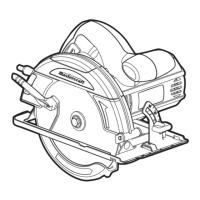
